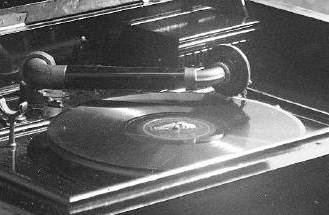




Despite the photo above and
the advertisement below, these records have been
transferred using a modern lightweight pickup and the
correct electronic equalization. (Though most of them
will have been played on wind-up gramophones during
their long life, the damage caused by the weight of
the soundbox and arm, concentrated in a sharp steel
needle, can be considerable and I would never allow
any of them to be further worn this way.)
All the transfers are from originals in my collection. The condition is, as you would expect, variable - some came from proper collectors' shops, some from second hand and charity shops - many of these records have been kicking around for 80 years and it's a wonder they have survived as well as they have.
Filtering was kept to a minimum, in order not to reduce the high frequencies and take the life out of the recordings: then digital noise reduction was applied in two stages - de-crackle and de-hiss - using ClickRepair and DeNoise by Brian Davies (no longer available). Again, care was taken not to overdo it: most commercial issues seem to aim for removing as much noise as they possibly can, and the results are usually rather dull-sounding compared with the originals. I aim to damage the original sound as little as possible, even though this may mean leaving a little more surface noise (and even so it's a vast improvement on the un-processed sound).
You can hear four brief 'before and after' demonstrations by clicking on the buttons below:
All the transfers are from originals in my collection. The condition is, as you would expect, variable - some came from proper collectors' shops, some from second hand and charity shops - many of these records have been kicking around for 80 years and it's a wonder they have survived as well as they have.
Filtering was kept to a minimum, in order not to reduce the high frequencies and take the life out of the recordings: then digital noise reduction was applied in two stages - de-crackle and de-hiss - using ClickRepair and DeNoise by Brian Davies (no longer available). Again, care was taken not to overdo it: most commercial issues seem to aim for removing as much noise as they possibly can, and the results are usually rather dull-sounding compared with the originals. I aim to damage the original sound as little as possible, even though this may mean leaving a little more surface noise (and even so it's a vast improvement on the un-processed sound).
You can hear four brief 'before and after' demonstrations by clicking on the buttons below:


(If you would like more
information on digital noise reduction I have written
an article with audio examples.)
The picture in the header for each page is taken from the 1914 HMV catalogue (with the lettering amended) as is the advertisement below for steel needles.
Roger Wilmut
The picture in the header for each page is taken from the 1914 HMV catalogue (with the lettering amended) as is the advertisement below for steel needles.
Roger Wilmut
